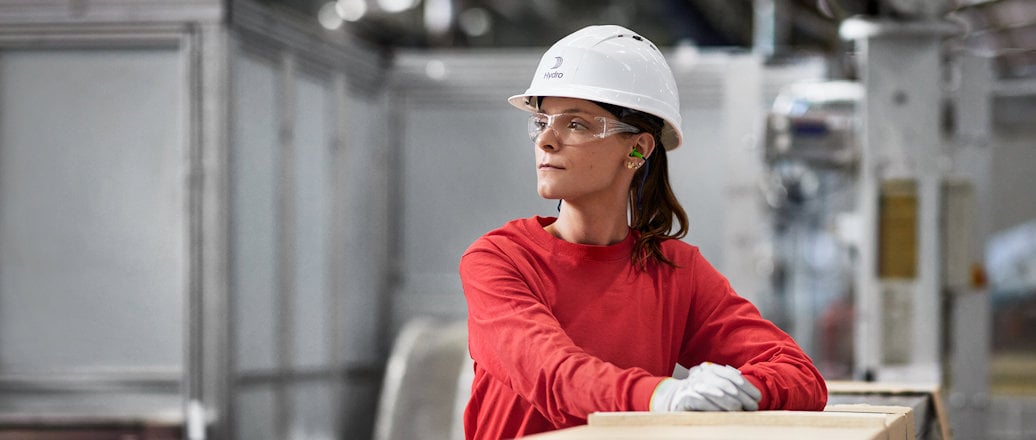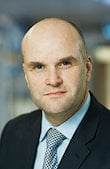- Results down on weaker demand and recycling margins, revenue drivers increasing
- Increasing recycling and post-consumer scrap capacity, supporting greener product offering
- Mendubim and Boa Sorte solar plants in commercial operation, securing renewable power for Hydro
- Hydro Alunorte starts using natural gas, improving profitability and executing decarbonization roadmap
- CO2 compensation agreement supporting decarbonization and greener investments
Health and safety remain Hydro’s top priority for both employees and the communities where the company operates. The total recordable injury rate (TRI) continues a positive trend, reaching 2.3 by the end of first quarter.
"Despite weaker markets impacting results, the macroeconomic indicators as well as revenue drivers are showing signs of improvement towards year end. Hydro is well positioned to capitalize on strengthening demand for aluminium products,” says President and CEO, Hilde Merete Aasheim.
The economic outlook improved during the first quarter, reducing the risk of recessions and central banks are re-considering rate cuts amid easing inflation. Primary aluminium demand outside China slowed and was down 2 percent year-on-year, while Chinese demand remained robust in renewables and electric vehicles (EV), supporting overall growth in global primary demand of 5 percent year-on-year.
Residential and industrial building construction demand remained muted through the quarter, especially in Europe. The weak building and construction market continues the pressure on billet premiums. Decreased construction and demolition activity also leads to lower aluminium scrap generation. Coupled with rising scrap exports to Asia, this supports elevated scrap prices, squeezing recycling margins in both Metal Markets and Hydro Extrusions.
Despite continued growth in EV and hybrid demand, projections were tempered due to subsidy cuts in Germany and heightened competition from China. Reduced EV production in Europe had an adverse effect in Hydro Extrusions during the first quarter, being exposed to the EV segment. The North American transport segment faced constraints from low trailer build rates.
Positive indicators emerged during the first quarter with revenue drivers like LME, premiums and alumina prices showing signs of improvement. LME aluminium prices increased at the end of the quarter and into April, rising above USD 2,500 per tonne mid-April. European and the U.S. ingot premiums rose, indicating market optimism. Alumina prices trended upward, reaching USD 378 per tonne mid-April, influenced by Chinese production challenges. On April 12, the U.S. and UK sanctions restricted trade of Russian aluminium, banning imports of metal produced after April 13. Hydro ceased purchasing Russian aluminium after the Ukraine invasion in 2022, and urges the EU to sanction Russian aluminium in the forthcoming fourteenth package, expected in May.
Through ongoing improvement programs and commercial initiatives, Hydro continues to reinforce robustness and remains on track to deliver additional improvements of NOK 8.5 billion by 2030.
Hydro continues to safeguard recycling margins and secure scrap in the short term, while securing long-term growth through expanding scrap sourcing and utilization. Recent milestones, including the inauguration of new recycling units at Hydro Årdal and Hydro Høyanger, will increase annual recycled aluminium capacity by more than 60,000 tonnes, supporting the Hydro REDUXA 3.0 offering. Hydro also entered a multi-year agreement with Sims Alumisource in North America to secure access to 36,000 tonnes of post-consumer aluminium scrap. Plans to build a scrap sorting plant at the Wrexham casthouse in the UK, with 30,000 tonnes of scrap sorting capacity, will enable Hydro to process and recycle a wider range of post-consumer aluminium scrap. These initiatives reinforce Hydro's market presence within recycling, fostering growth and resilience in alignment with the 2030 recycling targets.
Hydro Extrusions is committed to expanding its market presence through strategic investments aimed at lifting profitability and sustainability. Hydro Extrusions is growing with the customers and four new OEM contracts were signed since Capital Market Day in November, accumulating contracts worth EUR 1.9-2.0 billion since the beginning of 2023. Additional EUR 0.9-1.0 billion worth of contracts are in process, promising solid EBITDA contributions with attractive margins. Through ongoing partnerships, invested capacity expansions and sustainability focus, Hydro Extrusions is positioned to deliver on the 2025 EBITDA target of NOK 8 billion when markets recover.
“We have made good progress on our decarbonization agenda this quarter. Hydro Rein has successfully brought Mendubim and Boa Sorte into commercial operation on time and on budget, supplying Alunorte and Albras with affordable renewable energy. At Alunorte, we are now producing alumina fueled by LNG, with significant CO2 reduction, as well as cost savings when fully ramped up by the second half of this year, lifting profitability and driving sustainability,” says Aasheim.
Securing access to renewable power is crucial for growing in low-carbon aluminium. In Energy, Hydro has secured two new long-term power purchase agreements (PPAs) during the first quarter. Statkraft will supply 1.28 TWh from 2024 to 2027, and Alpiq will provide 0.54 TWh from 2025 to 2033. Hydro Rein has started commercial operations in the Brazilian solar plants Mendubim and Boa Sorte, providing approximately 1.55 TWh of renewable power to Hydro Alunorte and the Albras smelter. Both projects were delivered on time and cost. The transaction with Macquarie Asset Management is progressing as planned and is expected to be completed by the end of the second quarter.
During the first quarter, Hydro executed on its ambitious decarbonization roadmap, aiming for a 30 percent reduction in carbon emissions by 2030. At Alunorte, fuel switching and boiler electrification are driving this effort, enabling the production of low-carbon smelter grade alumina. Hydro Alunorte started producing alumina with natural gas in March and this is expected to cut annual emissions by 700,000 tonnes of CO2, yielding substantial cost savings estimated at USD 160 to 190 million annually based on current spot and forward price spreads when fully implemented by the second half of this year. This is supporting the ongoing work to lift profitability above 10 percent adjusted RoaCE in Bauxite & Alumina.
Regulatory advancements include the agreement on the CO2 compensation scheme in Norway, effective from 2024 to 2030, setting an annual maximum compensation of NOK 7 billion, eliminating the CO2 quota price floor, and requiring participating industries to implement emission reduction measures equivalent to 40 percent of the compensation received.
“The recently announced agreement with Norwegian authorities on the future of the CO2 compensation scheme is an important enabler for our continued investments in decarbonizing our Norwegian portfolio, while providing predictability towards 2030,” says Aasheim.
The revised CO2 compensation scheme will be subject to approval by EFTA Surveillance Authority (ESA), as well as the Norwegian parliament’s annual approval as part of the ordinary state budget process.
Results and market development per business area
First quarter adjusted EBITDA for Bauxite & Alumina increased compared to the first quarter of last year, from NOK 437 million to NOK 804 million, driven by decreased raw material prices partly offset by lower sales volume from lower production. PAX started the quarter at USD 350 per tonne and increased to USD 372 per tonne in mid-January, driven by higher Chinese alumina prices on the back of refinery curtailments in China and concerns around bauxite shipments from Guinea following an explosion at the main fuel depot of the country in December 2023. PAX traded in a narrow range throughout the quarter, ending the quarter at USD 365 per tonne.
Adjusted EBITDA for Energy in the first quarter increased compared to the same period last year, from NOK 726 million to NOK 1,152 million. Lower prices, lower gain on price area differences, and lower trading and hedging results were more than offset by the expiry of a 12-month internal fixed price purchase contract from Aluminium Metal at a significant loss in the same period last year. Average Nordic power prices in the first quarter ended below prices in the same quarter last year and slightly higher compared to the previous quarter. Price area differences between the south and the north of the Nordic market region declined compared to the previous quarter and were significantly lower than the same quarter last year. The decline was primarily a result of lower prices in the south due to weather and hydrology as well as lower continental spot prices.
Adjusted EBITDA for Aluminium Metal decreased in the first quarter of 2024 compared to the first quarter of 2023, from NOK 3,972 million to NOK 1,965 million, mainly due to lower all-in metal prices, reduced contribution from power sales, and increased fixed cost, partly offset by reduced carbon cost and positive currency effects. Global primary aluminium consumption was up 5 percent compared to the first quarter of 2023, driven by an 8 percent increase in China. The three-month aluminium price decreased slightly throughout the first quarter of 2024, starting at USD 2,384 per tonne and ending the quarter at USD 2,337 per tonne.
Adjusted EBITDA for Metal Markets decreased in the first quarter compared to the first quarter of 2023, from NOK 669 million to NOK 269 million, due to lower results from recyclers and reduced results from sourcing and trading activities. Lower results from recyclers are due to reduced sales premiums in a weakening extrusion ingot market.
Adjusted EBITDA for Extrusions decreased in the first quarter compared to the first quarter of 2023, from NOK 2,223 million to NOK 1,437 million, driven by lower extrusion sales volumes and decreased margins from recyclers. General inflation pressured fixed and variable costs, partly offset by cost measures and currency effects. European extrusion demand is estimated to have decreased 10 percent in the first quarter of 2024 compared to the same quarter last year, but increasing 7 percent compared to the fourth quarter of 2023 partly driven by seasonality. Annual demand growth for residential building and construction, and industrial segments remains negative, but to a lesser extent than previous quarters as demand has started to stabilize. Automotive demand has been challenged by weaker production of electric vehicles, negatively impacting order intakes. North American extrusion demand is estimated to have decreased 9 percent during the first quarter of 2024 compared to the same quarter last year, but increasing 10 percent compared to the fourth quarter of 2023 partly driven by seasonality. The transport segment has been particularly weak, driven by lower trailer build rates. Demand continues to be moderate in the residential building and construction, and industrial segments.
Other key financials
Compared to the fourth quarter 2023, Hydro’s adjusted EBITDA increased from NOK 3,737 million to NOK 5,411 million in the first quarter 2024. Higher realized aluminium and alumina prices combined with higher Extrusions and recycling volumes and reduced fixed costs, were partly offset by lower production in Bauxite & Alumina and negative currency effects.
Net income (loss) amounted to NOK 428 million in the first quarter of 2024. Net income (loss) included a NOK 50 million unrealized derivative loss on LME related contracts, a net foreign exchange gain of NOK 135 million, a NOK 24 million gain from unrealized derivative power and raw material contracts, and NOK 32 million in rationalization charges and closure costs.
Hydro’s net debt increased from NOK 8.2 billion to NOK 13.9 billion during the first quarter of 2024. The net debt increase was mainly driven by tax payments, performance based renumerations, investments of NOK 3.7 billion and net operating capital build, partly offset by EBITDA contribution.
Adjusted net debt increased from NOK 18.0 billion to NOK 22.5 billion, mainly due to the increase in net debt of NOK 5.7 billion, which was partially offset by a decrease in pension liabilities and financial liabilities.
Hydro’s existing share buyback program, initiated in September 2023, completed its purchases in the market on January 31, 2024. The redemption and cancellation of shares held by the Norwegian state is subject to approval by the Annual General Meeting on May 7, 2024.
The information was submitted for publication from Hydro Investor Relations and the contact persons set out above. Certain statements included in this announcement contain forward-looking information, including, without limitation, information relating to (a) forecasts, projections and estimates, (b) statements of Hydro management concerning plans, objectives and strategies, such as planned expansions, investments, divestments, curtailments or other projects, (c) targeted production volumes and costs, capacities or rates, start-up costs, cost reductions and profit objectives, (d) various expectations about future developments in Hydro's markets, particularly prices, supply and demand and competition, (e) results of operations, (f) margins, (g) growth rates, (h) risk management, and (i) qualified statements such as "expected", "scheduled", "targeted", "planned", "proposed", "intended" or similar. Although we believe that the expectations reflected in such forward-looking statements are reasonable, these forward-looking statements are based on a number of assumptions and forecasts that, by their nature, involve risk and uncertainty.
Various factors could cause our actual results to differ materially from those projected in a forward-looking statement or affect the extent to which a particular projection is realized. Factors that could cause these differences include, but are not limited to: our continued ability to reposition and restructure our upstream and downstream businesses; changes in availability and cost of energy and raw materials; global supply and demand for aluminium and aluminium products; world economic growth, including rates of inflation and industrial production; changes in the relative value of currencies and the value of commodity contracts; trends in Hydro's key markets and competition; and legislative, regulatory and political factors. No assurance can be given that such expectations will prove to have been correct. Except where required by law, Hydro disclaims any obligation to update or revise any forward-looking statements, whether as a result of new information, future events or otherwise. This information is considered to be inside information pursuant to the EU Market Abuse Regulation and is subject to the disclosure requirements pursuant to Section 5-12 the Norwegian Securities Trading Act.
Publié: 24 avril 2024









